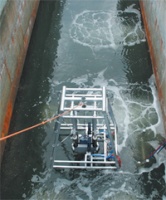The 2011 Shortlist - Marine

SEARASER
Dartmouth Wave Energy, Exeter University
Wave power is often talked about as the one truly dependable renewable energy source that the UK has in abundance. Tidal turbines are progressing but are still expensive and potentially difficult to maintain.
The SEARASER is a simple vertical pump that moves up and down with the crest and troughs of waves in open sea, near to the coastline.
It pumps water to a high head-holding tank or purpose-built reservoir on shore (anything up to 100m above sea level), then sends it back down to the sea driving turbines, thus enabling on-demand hydro energy in the form of stored water. The SEARASER was invented in 2006 by Alvin Smith and was subsequently patented. A prototype was demonstrated for one month in the open sea by Dartmouth Wave Energy (DWE) in 2009.
Having proven the concept, DWE needed to expand and execute the SEARASER concept through a recognisable institution – Exeter University.
Register now to continue reading
Thanks for visiting The Engineer. You’ve now reached your monthly limit of premium content. Register for free to unlock unlimited access to all of our premium content, as well as the latest technology news, industry opinion and special reports.
Benefits of registering
-
In-depth insights and coverage of key emerging trends
-
Unrestricted access to special reports throughout the year
-
Daily technology news delivered straight to your inbox










Water Sector Talent Exodus Could Cripple The Sector
Well let´s do a little experiment. My last (10.4.25) half-yearly water/waste water bill from Severn Trent was £98.29. How much does not-for-profit Dŵr...